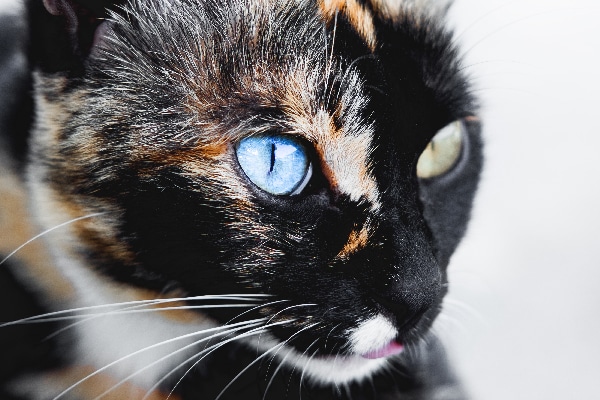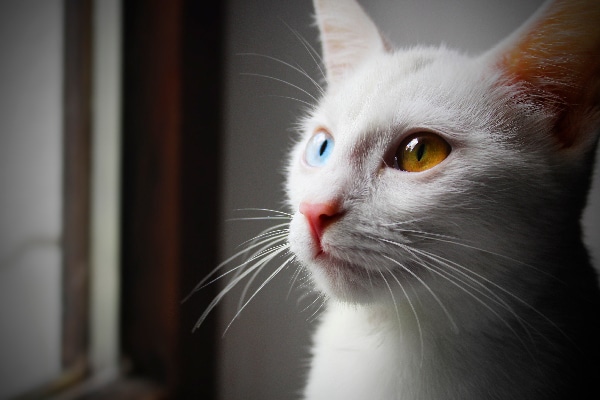Cat eyes come in a variety of gorgeous colors, from gold to copper to orange to green to blue. Interestingly, cat eyes are always light-colored — cats don’t have dark brown eyes like dogs or people might. Sometimes cats have two different-colored eyes, sometimes referred to as “odd eyes.” This striking phenomenon, called heterochromia, can also occur in dogs and even people. Heterochromia in cats might result in any number of eye combinations, such as one blue eye and one green, or one gold eye and one blue.
What cat breeds are likely to have heterochromia?

Heterochromia in cats is common in certain cat breeds like British Shorthairs, Cornish and Devon Rex, Japanese Bobtails, Munchkins, Persians, Scottish Folds, Siamese, Sphynxes, Turkish Angoras and Turkish Vans. It’s also common in white cats of any breed.
How does heterochromia in cats occur?
The iris is the colored part of a cat’s eye. “The color of the iris is determined by the presence of pigment, also known as melanin,” says Doug Payne, DVM, medical director of VCA East Penn Animal Hospital in Pen Argyl, Pennsylvania.
What types of heterochromia might a cat have?
Heterochromia in cats may be hereditary (the cat was born that way) or acquired (the cat’s eyes change color over time). Hereditary heterochromia in cats has three variations:
- Complete, called heterochromia irides (one eye is an entirely different color than the other eye).
- Sectoral (part of the cat’s iris is blue and the rest of that eye is a different color).
- Central (different colors within the iris give a spiked or haloed appearance).
“Cats seem to have complete heterochromia more often, but sectoral and central forms can also be seen,” Dr. Payne explains.
In cases of acquired heterochromia in cats, a loss of pigmentation in the iris happens because of some other cause. “This can be attributed to many factors, such as inflammatory conditions, physical injuries and even certain medications,” Dr. Payne says. “There are many other conditions that may affect eye color in dogs and cats. Some of these conditions can be very uncomfortable for pets and if left unaddressed could lead to permanent damage or even loss of vision.”
What should you do if you notice a change in your cat’s eye colors?
If you notice a color change in your cat’s eyes or if you suspect that your cat’s eyes are bothering her, bring her in to the veterinarian for an eye exam. “Other conditions that can cause color changes in the eyes that are not associated with heterochromia can include cataracts, glaucoma, corneal dystrophy, uveitis, nuclear sclerosis, underdeveloped optic nerve and retinal dysplasia,” Dr. Payne explains.
Does heterochromia in cats ever lend itself to other medical issues?

White cats with one or more blue eyes have a higher incidence of congenital deafness, but such cats are no more prone to blindness than other cats.
Tell us: Do you have a cat with heterochormia?
Thumbnail: Photography ©vladimir šifliš | iStock / Getty Images Plus.








